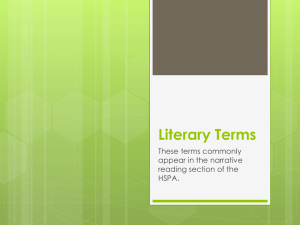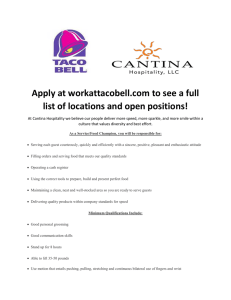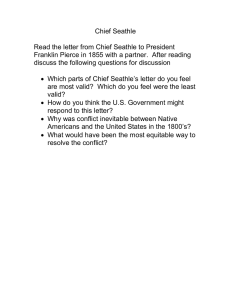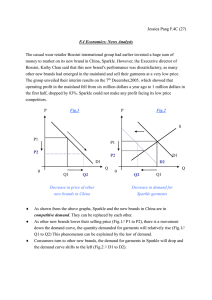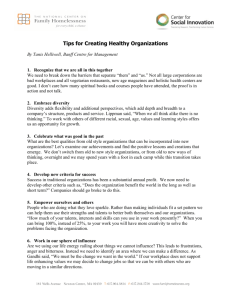Next up we have KAIST Korea Advanced Institute of Science... Korea. It's their first time participating in Design Expo. ...
advertisement
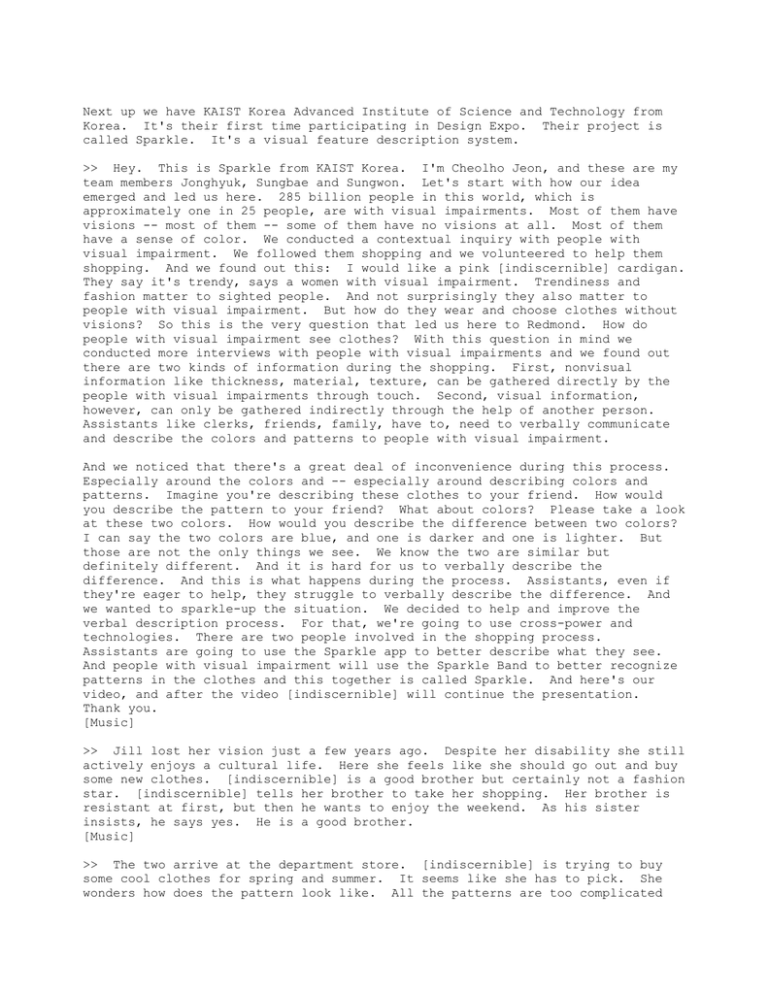
Next up we have KAIST Korea Advanced Institute of Science and Technology from Korea. It's their first time participating in Design Expo. Their project is called Sparkle. It's a visual feature description system. >> Hey. This is Sparkle from KAIST Korea. I'm Cheolho Jeon, and these are my team members Jonghyuk, Sungbae and Sungwon. Let's start with how our idea emerged and led us here. 285 billion people in this world, which is approximately one in 25 people, are with visual impairments. Most of them have visions -- most of them -- some of them have no visions at all. Most of them have a sense of color. We conducted a contextual inquiry with people with visual impairment. We followed them shopping and we volunteered to help them shopping. And we found out this: I would like a pink [indiscernible] cardigan. They say it's trendy, says a women with visual impairment. Trendiness and fashion matter to sighted people. And not surprisingly they also matter to people with visual impairment. But how do they wear and choose clothes without visions? So this is the very question that led us here to Redmond. How do people with visual impairment see clothes? With this question in mind we conducted more interviews with people with visual impairments and we found out there are two kinds of information during the shopping. First, nonvisual information like thickness, material, texture, can be gathered directly by the people with visual impairments through touch. Second, visual information, however, can only be gathered indirectly through the help of another person. Assistants like clerks, friends, family, have to, need to verbally communicate and describe the colors and patterns to people with visual impairment. And we noticed that there's a great deal of inconvenience during this process. Especially around the colors and -- especially around describing colors and patterns. Imagine you're describing these clothes to your friend. How would you describe the pattern to your friend? What about colors? Please take a look at these two colors. How would you describe the difference between two colors? I can say the two colors are blue, and one is darker and one is lighter. But those are not the only things we see. We know the two are similar but definitely different. And it is hard for us to verbally describe the difference. And this is what happens during the process. Assistants, even if they're eager to help, they struggle to verbally describe the difference. And we wanted to sparkle-up the situation. We decided to help and improve the verbal description process. For that, we're going to use cross-power and technologies. There are two people involved in the shopping process. Assistants are going to use the Sparkle app to better describe what they see. And people with visual impairment will use the Sparkle Band to better recognize patterns in the clothes and this together is called Sparkle. And here's our video, and after the video [indiscernible] will continue the presentation. Thank you. [Music] >> Jill lost her vision just a few years ago. Despite her disability she still actively enjoys a cultural life. Here she feels like she should go out and buy some new clothes. [indiscernible] is a good brother but certainly not a fashion star. [indiscernible] tells her brother to take her shopping. Her brother is resistant at first, but then he wants to enjoy the weekend. As his sister insists, he says yes. He is a good brother. [Music] >> The two arrive at the department store. [indiscernible] is trying to buy some cool clothes for spring and summer. It seems like she has to pick. She wonders how does the pattern look like. All the patterns are too complicated for her brother to explain. She does not just stand there and watch. She uses her Sparkle. The Sparkle then delivers information about [indiscernible] displayed on the braille display. [Indiscernible] uses the Sparkle app. The Sparkle Band sends a visual data to the Sparkle app and the Sparkle app displays suitable description words of the visual data on the screen. [Indiscernible] describes how the clothes look and feel with more detail from the help from the Sparkle. With her good brother and useful Sparkle she continues to shop. They shop and shop and shop until the brother begged her to stop. It seems like it was a nice day, at least for one of them, isn't it? [Applause] >> Let's talk some more about details. There are three main stakeholders in our system. First, everyone who can see denoted by green or gray. Second, the assistants of people with visual impairment denoted by green. And finally there are people with visual impairment marked red. We will describe how each user group contributes to and take advantage of our service. Let's say we have a piece of clothing that has some complex patterns. Using the camera, Sparkle band can transform the pattern information into braille that people with visual impairment can feel with their fingertip. So, how does it actually work? We have a software demo for this. The braille on the surface of the band will move up and down to create a texture that resembles the pattern. The color of each cell represents the height of each braille. So the wider the cell, the higher the corresponding braille piece. Now, let's see how sighted people and assistants are involved in our system. First, sighted people. When they shop for clothes online they'll be asked to do a small task for the people with visual impairment. The assistant will ask them to describe the colors they see with a few words. This processed data will be stored at the central database and it will be used by Sparkle app, Sparkle Band and other services. This processed data can be useful for everyone even sighted people. For example, Sparkle can offer advanced searching and rich color dictionary. With Sparkle's rich color vocabulary assistant, made by people, we can now search with a Curry like, three-piece baked tea and expect some clothes which match that description. Furthermore, now we have a color dictionary that also contains descriptors of emotions and feelings attached to colors. Designers can easily reference and pick colors accordingly. As you saw in the video, the assistants can use the Sparkle app to get recommendations and describe colors easier. Do you still remember these colors? We got some help from the crowd through surveys and this is what we got. Using the system, assistants can say about the color on the right, this is a light blue color which reminds me cloudy day and makes me relaxed. So people who acquired visual impairment can imagine colors easily with the descriptions given and people born with visual impairment can share the feelings that the sighted people feel from the color. And we will talk some more about the future applications of Sparkle. First, independence is important to all of us, but some of us don't fully enjoy it. We want to help people with visual impairment to shop freely on their own with Sparkle. Sparkle can drive them to the shopping mall they're looking for and let them choose clothes and describe colors and patterns to them. And, second, clothes are not the only ones that are hard to explain. Furniture, accessories, drawings. There are tons of things that are hard to describe. Sparkle makes, can make this describe easier. Thank you. Any questions? [Applause] >> Thank you Korea. Who would like to start? >> Great job, guys. I really like this concept. I think you guys have done an amazing job actually. You've got a ton of detail in here. There's the software service that you've designed, a platform for crowd-sourced information and subjective, qualitative descriptions of color. There's a hardware device in here, it's obviously got its own gamut of scenarios that you've only lightly touched on here. Not only that, the graphic communication work, the design of your presentation is really beautiful, the character design and all of those things. I think there's just tons to commend you on, and even looks like there was some software image processing work done just to do some live video presentation. And let me just say that quite a lot of that happened between Monday and today. So even more impressive for how far it's come. So well done. >> Thank you. >> So I think that was really interesting. I really like many aspects of this. I thought the braille, the sort of representation of patterns by sort of a tactile-pattern thing was really interesting. I don't know, it would be great to see some kind of progression on that and testing and how can people really feel it and what does it mean to have polka dots -- a lot of understanding patterns is really interesting. I liked the way that you thought about color and different ways of explaining that as well. I think it would have been great to see -- I was not completely convinced by the way that the wrist thing went with the app and the description of the color versus the pattern, I think that felt a little bit kind of disconnected. Apart from that, it was really nice, and you did a great job explaining it. >> Yeah, I think this is really, really neat. I mean, it took me -- maybe I'm a slow study -- it took me a while to get -- because the pattern that was taken off the rack had texture to it. It threw me off. You probably already heard this feedback. So I won't belabor the point. But once I got it I started to kind of appreciate the kind of expansiveness of what you guys were going for here. This is a lot of vision. I always worry in those situations it's a lot in the platform. But if you can produce that entire experience, I see the vision. I think it's really, really exciting. So what I was most excited about was the end result. I thought that the crowd-sourced actual description was really kind of very helpful, very meaningful kind of in that response. So just getting that part right in terms of how people give you the right words and how you discern that these are the right ones for this thing and for each of those cases -- each color, each garment -- that's a very expansive problem, even if you don't have hardware or anything else contributing to that. So I really, really like that part. I see that as a piece of it that in and of itself has a lot of value. I don't know if that helps you at all. But I do enjoy the project. I like the branding. I like the look. Congrats. A lot of great work. >> Thank you. [Applause] >> We have time for one question. >> [indiscernible] Cindy. >> So the question was if you guys did any thinking about shopping online, because when you shop online you have to rely a lot on the metadata that the website provides. >> So we actually met and have communicated with people with visual impairments and we asked about the online shopping. And the answer was, like, we were depressed to hear that they do not enjoy online shopping as much as we do. But they said that they use online shopping only with offline shopping. They go to the off line mall and wear it and try it out, then go back to their home and order it online because it's cheaper. And we did not quite think about how to make the online shopping better. That's all. Yes. >> Thank you. [Applause]
